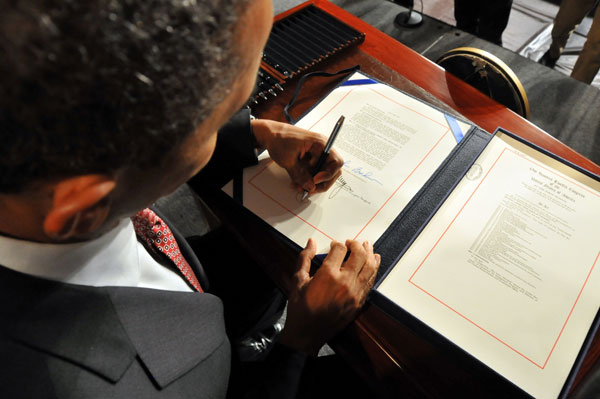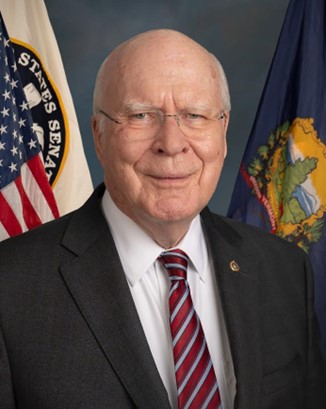Foreword
The idea to interview Senator Leahy, a titan of intellectual property legislation in the United States Senate, about the America Invents Act began shortly after the start of my internship with ipCapital Group. I am a graduating high school senior who began interning with ipCapital Group at the start of my senior year. This interview was an excellent opportunity and fit for me, as I have a particular interest in public policy; much of my internship focused on writing articles for the ipCapital blog, and it seems fitting that while my first article was A 10 Year Retrospective on Controversial America Invents Act, my last article of this internship will be this interview with Senator Leahy on that very same piece of legislation. I believed that an interview with the Senator on this particular topic and his views on intellectual property would be of interest to Vermonters and others, and am grateful that the Senator agreed to share his thoughts with me on this subject. All photographs contained within this article are courtesy of Senator Leahy’s Office, and I would like to thank the Senator and his staff for providing me with this incredible opportunity.
What drove your interest in the USPTO that led to the AIA?
Patents are a powerful tool for innovation, and I’ve always had a strong interest in supporting our country’s creators and innovators. In exchange for disclosing how an invention works, the public grants an inventor a time-limited right to exclude others from selling that inventive product. A patent protecting a genuine innovation can attract the funding necessary to build a business, provide legitimacy to a non-traditional inventor, and drive the economy by helping to create American jobs. Given the power that a patent conveys, ensuring that the U.S. Patent and Trademark Office (PTO) issues the highest quality patents possible is crucial to ensuring that the system works. Unfortunately, when the system produces patents that never should have issued in the first place, because the inventions are not new, there are negative consequences to our economy and society. Those patent owners can also exclude others from using valuable tools that should be available to the public. In drafting the Leahy-Smith America Invents Act, I had one overarching goal—to improve patent quality. As President Obama said to commemorate the signing of the AIA into law, the AIA was designed to “improve patent quality and help give entrepreneurs the protection and the confidence they need to attract investment, to grow their businesses, and to hire more workers.”
I would also encourage you to look at the legislative history that went into the AIA, available at: https://www.govinfo.gov/content/pkg/CRPT-112hrpt98/pdf/CRPT-112hrpt98-pt1.pdf. Pages 38 and onward detail the purpose and history of this bill.

What do you think is the most important change your AIA of 2012 made to the USPTO?
The AIA was the most significant change to the U.S. patent laws since 1952. We made a number of important changes that have improved the patent system in significant ways. One important improvement was increasing access to the patent system for ordinary Americans and individual inventors. We created a network of PTO satellite offices around the country, bringing the PTO closer to where Americans actually innovate. We lowered fees for small businesses and created a new micro-entity status to lower fees even further. We also created the patent pro bono program to help make patenting more accessible to prospective inventors.
A second important change was allowing parties to bring post grant and inter partes review challenges to patents in front of the Patent Trial and Appeal Board (PTAB) in a way that was faster, less expensive, and more accurate than district court litigation. Creating another mechanism besides district court litigation to challenge low quality patents gave competitors a cheaper, faster way to allow the PTO to cancel a patent that should never have been granted, allowing more businesses and innovators to thrive.
The post-grant and inter partes review proceedings improved upon the prior inter partes reexamination process, which was much slower and more expensive than the new proceedings. Those earlier inter partes reexamination proceedings were used very rarely. We hoped that, by promising more speed without sacrificing accuracy, we would encourage the public to use the new proceedings. But we did not know whether the new proceedings would be widely used. We were surprised by their usefulness. In just one year—2021—parties filed 1,401 petitions requesting either inter partes or post grant review. The popularity of these proceedings—and their effectiveness in simplifying district court proceedings—has been encouraging.

How do you find that the AIA has affected the US Patent Filing process?
The AIA switched the filing system in the United States. The United States had previously been the only country with a first-to-invent system, while all other countries had a first-to-file system that reduced the administrative burden of adjudicating disputes between different inventors who both claimed to have gotten there first. By harmonizing our system with the rest of the world, we have been able to create an even more effective global work sharing program. Additionally, by removing the administrative burden required to show someone invented something first, we simplified the patenting process and made it easier for ordinary Americans to understand.
How do you think that the PTAB has changed patent rights in the United States?
The PTAB has not changed patent rights in the United States. The PTAB applies the same patent laws as the courts, and the same laws as the rest of the PTO, of which it is part. The PTAB’s post-issuance proceedings are simply there to allow the public to request that the PTO review an issued patent and, if the agency never should have issued the patent in the first place, the PTAB can correct that error. Post-issuance proceedings allow a group of specialized and highly educated expert administrative patent judges to determine the validity of a challenged patent without the expense and delay of a district court proceeding.

What do you think of the recent Supreme Court decision to grant the Director of the USPTO the authority to grant IPR patents?
In United States v. Arthrex, the Supreme Court found that PTAB judges were principal officers because they could issue final decisions that bind the executive branch. 594 U.S. ____ (2021). The Appointments Clause of the United States Constitution requires that principal officers be appointed by the President “with the advice and consent of the Senate.” The Supreme Court decided that, to comply with the Appointments Clause, the PTO Director must have the authority to review PTAB decisions and have the final say in the patentability of any particular patent.
I respect the Supreme Court’s decision in this case. I also believe that it should be transparent to the public when decisions are being made by the civil servant PTAB judges and when decisions are being made by the politically accountable PTO Director. You can read my full statement from when this decision issued here.
What changes do you think still need to be made in the US intellectual property legislation?
I have a number of bills to improve the patent system. First, my Unleashing American Innovators Act would extend the PTO’s satellite offices even further to meet inventors where they are, in more parts of the country. It would also enhance the patent pro bono program to provide under-resourced inventors with access to the patent system.
Second, while the public can easily find out who is the named inventor on a patent, there is currently no requirement to inform the public when a patent changes hands. We require people to register when they buy houses and cars, yet if someone wants to license a patent there is not necessarily any way to find the patent owner and request a license. My Pride in Patent Ownership Act would incentivize patent owners to register with the PTO when a patent changes hands so the public has access to that vital piece of information about the patent.
Finally, learning from the first ten years with the PTAB, the Restoring the America Invents Act addresses areas that I would like to shore up. Under the last administration, the PTO began refusing to look at requests for post-issuance proceedings, based on factors having nothing to do with the merits of the patent. This practice has undermined the intent of the AIA to provide a faster, more accurate way of assessing a patent’s validity. This bill will ensure that meritorious challenges will be addressed by the PTO.
As the consensus support the Leahy-Smith America Invents Act received shows, good intellectual property policy is a bipartisan issue. Every inventor can benefit from better quality patents, improved access to the patent system for traditionally under-resourced inventors, and an application filing system in harmony with the rest of the world.

What do you think is important for Vermonters to know about intellectual property rights and the USPTO?
Every Vermonter, and every American, can be an inventor or creator. I’m inspired by the way Vermonters solve problems in their daily lives, dreaming up new ideas in their spare time, or tinkering in their garage or barn. My interest in intellectual property comes from appreciating that innate creativity of people and wanting the government to foster that innovative drive. When Vermonters decide to file an application before the PTO, they should know we have created a system designed to work for them. We have set up regional offices, a pro bono program, a patent ombudsman, and the Patents for Humanity awards program to encourage a diverse group of inventors to participate in our patent ecosystem.
Do you have any advice for the next Senator from Vermont, what would you like to see them do in Congress?
In terms of intellectual property, I would like to see whoever steps into my shoes continue this good work of supporting America’s innovators and creators and promoting a well-functioning patent system. I hope the Senate will continue to address those who would game the patent system for anti-competitive purposes. By continuing to tackle these issues, my successor could reduce drug prices, improve inventors’ access to the PTO, and ensure that our economy works for all Americans.

